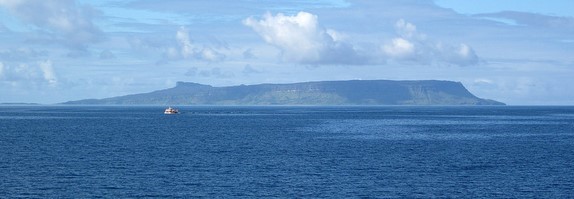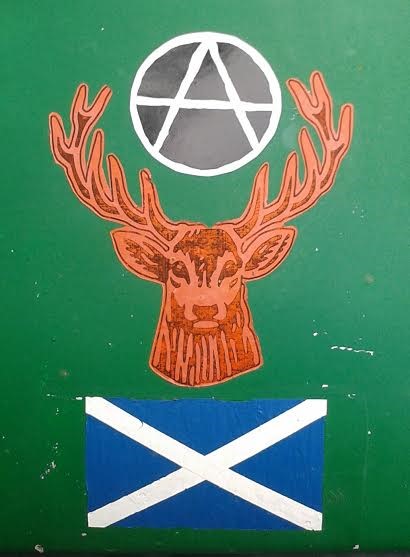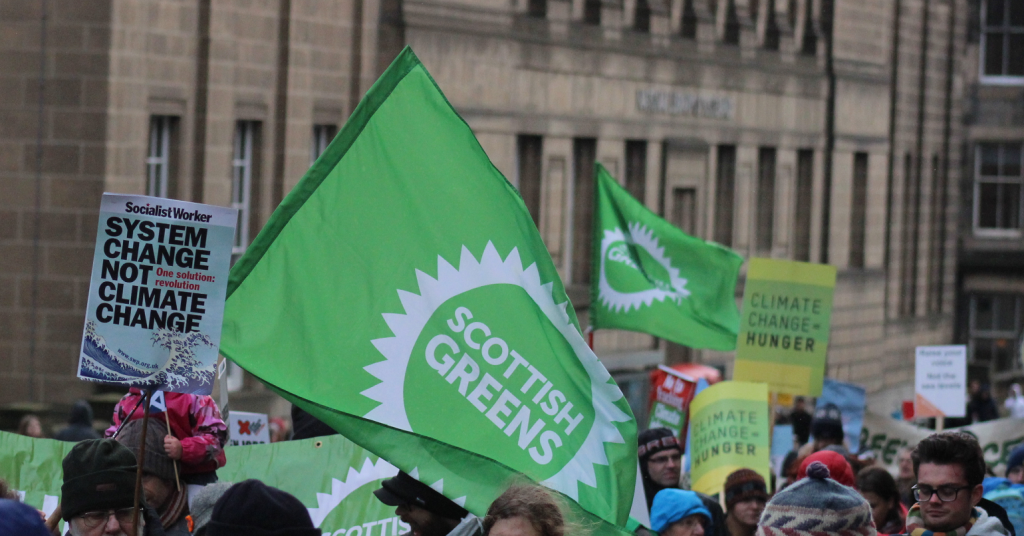Eco-socialism on one island: why the Isle of Eigg shows us the way forward

The sand beneath my feet is squeaking as I tread upon it. The water crashing against the shore is turquoise and clear. In the distance, to the west, the mountainous Isle of Rum sits majestically on the horizon. A sharp, strong wind gusts in from the North Atlantic. I am on the Singing Sands of Cleadale, on the inner-Hebridean Isle of Eigg – a modestly sized island which looks uncannily like an inverted comma, nestled just south of Skye.
Further up the shore, the tropical, turquoise-white clarity of the scene turns ugly. Strewn across the patch of land from underneath the high-tide waves is a de facto rubbish dump – filled with the flotsam and jetsam of the sea: bits of broken nets, tooth brushes, plastic bottles, toilet brushes. Happening upon the volunteers with the Scottish Wildlife Trust, who are busy collecting it all for disposal. They tell me that this is a combination of the rubbish thrown away by trawlermen, and that floated up from more densely populated areas of mainland Scotland.
Meeting with the Scottish Wildlife Trust’s young resident warden on the island, Dean Jones, he tells me that this pollution isn’t just contaminating Scotland’s otherwise pristine beaches. “Bottles break down into microscopic pellets. It enters the food chain. If you eat fish, you’re probably eating plastic. That’s why I gave it up. It’s called bio-magnification. We used to do beach samples all the time, it was scary. If you take the sand, pan it out, it’s almost 10 percent plastic.” The volunteers told me that the area of sea around the small isles has recently been designated an ‘MPA’, or ‘Marine Protected Area’, in the hope that the area will recover. “I’ve studied a little bit on MPAs and I know for a fact they help everyone out, including fishermen. If you just close off one small area that place will flourish, and everything outside of that,” Dean says.
Such an encounter exemplifies what the Isle of Eigg is about and the types of people it attracts. A haven for the free-spirited, Eigg is not just an outlier geographically, it is an outlier politically. The island has made a name for itself for pioneering Scotland’s ongoing land reform agenda, thanks in part to the campaigning journalism of Lesley Riddoch and Alastair McIntosh. The pattern of land ownership in Scotland is possibly the most unequal of any country in the democratic world, with 432 people owning some 50 percent of Scotland’s private land. Eigg breaks that trend, being owned and run by the people who live there, through the Eigg Heritage Trust.
Their story is unlikely and unique. Eigg residents launched their bid in July 1991 after reaching the end of their tether with their then-Laird, Keith Shellenberg, whose reign over the island residents saw as tempestuous and indifferent. Self-styled ‘human ecologist’ Alastair McIntosh documents the story in his book Soil and Soul: People vs Corporate Power: “It was not unknown for a family to be evicted for not running out to open the gate for the Laird’s Range Rover, or a crofter having to pay for seaweed to fertilize a potato patch,” he writes. “Even requests for a community rubbish dump had got nowhere. Most residents therefore had heaps of rat-infested garbage at the bottom of their gardens.”
Their subsequent struggle befits Gandhi’s aphorism about all confrontations with power: to be ignored, laughed at, fought against, and then victorious. Launching their bid at a hotel in Edinburgh, McIntosh writes that the room “collapsed in laughter” in response to such an audacious bid. But over time, as the Trust picked up support and the spiritual backing of the wider population, Laird Schellenberg fought back, calling the residents “a lot of publicity seeking windbags”, with McIntosh saying that “in subsequent media debates he variously accused me of being a Marxist, a covertly aspiring Laird, and even an IRA terrorist.”
But then they won. Laird Schellenberg quietly sold up, passing over for a brief two-year period to another German landowner who went bankrupt, leaving the islanders to buy the land off administrators. An anonymous donor, presumably heartened by their story, granted them the extra money they needed, adding to what they had raised through fundraising efforts. ‘Independence Day’ for them (as it became known) was on the 12th June, 1997 – an anniversary celebrated raucously every summer. “It was an archetypical David vs Goliath situation”, McIntosh writes, adding that it almost changed the national psyche: “it was now seriously legitimate to think of challenging landed power.”
Since that time, a series of positive transformations have flowed, including for Scotland itself. Their experience ensured that land reform has been one of the foremost issues dealt with by the Scottish Parliament since it was re-convened in 1999. Two substantial pieces of legislation have since been passed: the Land Reform Act 2003, which officially abolished feudalism and gave communities the right to buy with help from a Scottish Land Fund; and the Land Reform Act 2016, which gave power to tenant-farmers to buy the land off neglectful lairds and established a Commission to keep the issue on the agenda. To give people a sense of how antiquated the status quo in Scotland is – in 2016 Holyrood passed a Succession Bill, which aimed to remove the right of lairds to pass their land, in its entirety, to only their eldest son.
Meeting with Maggie Fyffe – the Secretary of the Eigg Heritage Trust and described as the “towering power” behind the movement to reclaim the island – she explains the positive transformations for Eigg itself. She tells me that because of the Heritage Trust, profits from island enterprises can be reinvested for the benefit of the community as a whole: “We’ve made buildings available to residents to run their own businesses. Eigg Trading was one of the first subsidiaries we set up, and we set that up to [erect] the building at the pier. We’d already identified as a community what folk saw as the priority, and a new shop and tea room were top of that list. They pay rent to Eigg Trading, and that generates income to keep that building in working order.”
One of the island’s biggest achievements is Eigg Electric. Completely off-grid, the island now runs off its own, community-owned renewable energy project. Formerly, the island got its electricity from diesel generators, but after winning grants from the EU Structural Fund and the NESTA Challenge, they erected their own solar panels, hydro-dams, and wind turbines – with 90% of their energy coming from these sources. Very occasionally, the system doesn’t provide enough to keep everything on, but the islanders have developed a more comfortable symbiosis with nature’s rhythms: “It’s even [distribution]. Because people had generators before, people here are far more aware of what each piece of equipment uses. If you exceed your 5KW [cap] your trip switch goes. Hardly ever happens. Hardly ever,” says Fyffe.
Without community ownership, its unlikely such a project would have got off the ground. A common problem with renewable energy projects in Britain to date is that they are owned and run by private interests – imposed with little say by the local community. When owned and run by the communities where they are built, they are a big success. As Naomi Klein puts it in her recent book on capitalism and climate change, This Changes Everything: “It’s [not] large corporate-owned wind and solar operators that have the best track record for spurring renewable energy turnarounds – it’s communities, co-ops, and farmers…de-centralization delivers.”
As Maggie Fyffe says: “We went through every process with the community to make sure we had people’s backing.” Asking if it would have happened previously, under their Laird, she says “The man wouldn’t give us a piece of land to build a hall on never mind anything else.” The money, of course, going back to the community who live there. “It washes its face pretty well,” Fyffe says.
Since the community buy-out, the island has also had the space to recover ecologically and rewild. A common criticism – made by the likes of George Monbiot and Lesley Riddoch – is that if land is retained in the hands of a few, it is preserved as a mono-culture: only for the purposes of deer stalking and grouse shooting, the leisure pursuits of the rich. This often means keeping the land empty of and clear of woodland. Dean Jones told me: “They [landowners] burn the heath-lands. I used to do a lot of nest reporting. It’s awful. [Land reform] should be done for the native wildlife.”

More even distribution, however, offers the chance for a pluralistic use of land, with the ecological regeneration developing in tandem with economic regeneration. There is a perception that Highland-dwellers have a lot of money behind them, but in reality it is “completely opposite”, says Maggie Fyffe, with widespread rural poverty. Alistair McIntosh wrote: “A five-year woodland regeneration programme employed six people, replanting native trees and fencing overgrazed areas to allow for natural regrowth. In May 2001, the corncrake, a rare bird absent for twenty years, returned.” Since the buy-out, Eigg’s population has grown from around 64 to around 98 today.
For all that Eigg may be described as socialism on one island, McIntosh wrote that Eigg was pursuing a different, decentralized style: “The idea of the Heritage Trust was not to make the residents into owners in the private sense of that word. This would be a third-way approach to land holding: communitarian, rather than capitalist or communist.” Eigg is a living example of a new ideology – eco-socialism: equitable distribution of the fruits of the earth, within its ecological limits.
Sitting in the centre of the island is the most charming of symbols. The grandiose former Laird’s house sits in an exotic garden, painted yellow and drenched in sunshine. It is now home to Earth Connections – a small organization which runs courses for people seeking to re-connect with nature and learn practical environmental skills. “That’s a story in itself. When we became owners of it it was in an appalling condition, full of dry rot,” Maggie Fyffe told me. A symbol of alienation has become a symbol for re-connection. During the buy-out years, McIntosh reports, an anonymous unemployed man from London sent the Trust a cheque for £2, enclosing a letter with one small message: “It gives me hope,” it read simply.



I never heard of Isle of Eigg before, and there is me thinking I know all the Islands, sounds great, really interestig article, is it possible to use the info for my blog nessieland.com? i would love to have an article written about the island!
The prime example of renewables on one island is on Samso in the Baltic. I wrote about this a while ago: https://wordpress.com/post/martinatgreenleeds.wordpress.com/22.
Here again the important elements were community involvement in decision making, seed funding (again from the EU in part), committed ‘leaders’, and a mix of alternatives.
A good piece, thank you Stuart